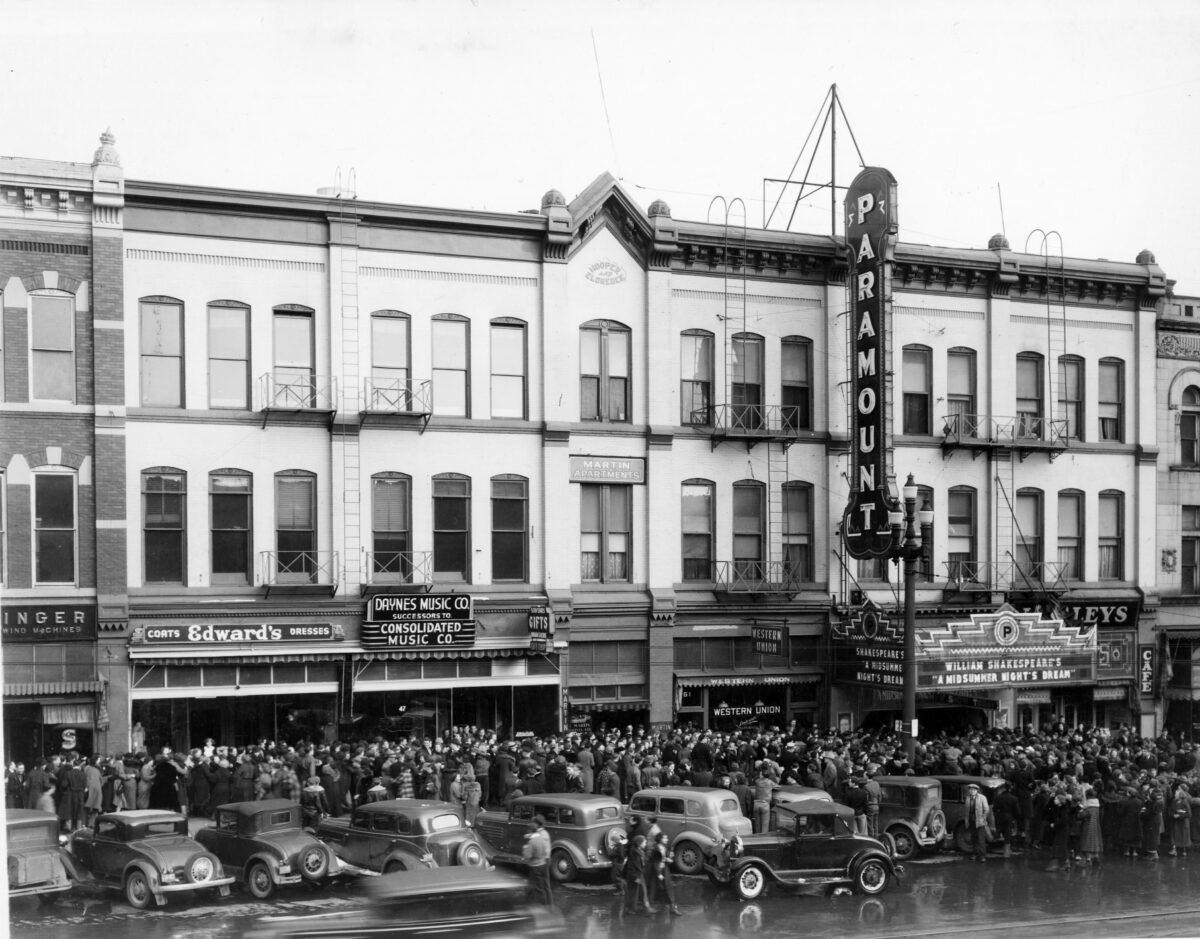A curated reading list. Last updated July 7, 2025.
First invented in the late nineteenth century as silent “moving pictures,” movies became popular in the world of entertainment in the early twentieth century. Following national trends, Utah’s residents gained a love for movies, and the Utah moviemaking industry began, consisting of a number of notable producers, actors, and film companies. As the popularity of movies grew, Utah’s residents constructed grand movie theaters, creating exotic atmospheres for film viewing.
Not only were movies popular in Utah, but many movies were created about Utah, featuring numerous peoples and events from the state’s history, such as the pioneer trek to Utah, Native Americans, the early Church of Jesus Christ of Latter-day Saints, and the Mountain Meadows Massacre. Furthermore, southern Utah’s red, rocky terrain became the set of hundreds of movies throughout the years, leading many to recognize Utah’s Monument Valley as the image of the Old West.
The following readings shed light on the interesting details of the growth of the movie industry in Utah, highlighting famous people, places, and ideas native to the state.
The History
Utah Filmmakers of the Silent Screen | “Utah Filmmakers of the Silent Screen” tells the story of Utah’s film industry before the 1930s, which, because of the newness of the technology, consisted of silent films. This article explains the popularity of movies in Utah and outlines the development of the film industry in the state, such as different film companies, movies created about the people of Utah, and famous directors and film company owners from Utah.
Reading: https://issuu.com/utah10/docs/uhq_volume43_1975_number1/s/114111
Source: Nelson, Richard. “Utah Filmmakers of the Silent Screen.” Utah Historical Quarterly 43, no. 1 (Winter 1975): 4–25. doi: https://doi.org/10.2307/45059447.
Going to the Movies: A Photo Essay of Theaters | “Going to the Movies: A Photo Essay of Theaters” captures the emergence of movie-theater architecture in Utah throughout the first half of the twentieth century using pictures. The trends in movie theater design in Utah matched that of America’s theaters on a national level—grand and exotic, creating an adventurous, otherworldly atmosphere.
Reading: https://issuu.com/utah10/docs/uhq_volume67_1999_number2/s/163140
Source: Roper, Roger. “Going to the Movies: A Photo Essay of Theaters.” Utah Historical Quarterly 67 no. 2 (Spring 1999): 111–22. doi: https://doi.org/10.2307/45062514.
Famous People
“When You Wish Upon A Star”: The Musical Legacy of Utah Composer Leigh Harline | Sandra Brimhall and Dawn Brimhall record the exceptional life of Leigh Harline, a famous movie composer born in Salt Lake City, Utah. This biography describes Harline’s upbringing by Swedish immigrant parents and his rise to musical prominence. As the title suggests, Harline is remembered most notably for his 1940 Disney composition “When You Wish upon a Star,” which became a hopeful message as the world, still recovering from the Great Depression, entered into World War II.
Reading: https://issuu.com/utah10/docs/uhq_volume85_2017_number2/s/164115
Source: Brimhall, Sandra Dawn, and Dawn Retta Brimhall. “‘When You Wish upon a Star’: The Musical Legacy of Utah Composer Leigh Harline.” Utah Historical Quarterly 85, no. 2 (Spring 2017): 162–78. doi: https://doi.org/10.5406/utahhistquar.85.2.0162.
Sara Alexander: Pioneer Actress and Dancer | This article centers on the life and accomplishments of Sara Alexander, a Latter-day Saint actress who crossed the plains with the Mormon pioneers. Acting in Utah during the “golden age of theatre,” Sara performed in numerous plays in the late nineteenth century, and eventually several silent films in the early twentieth century, such as Passion Flower, Custard Cup, and Little Miss Happiness.
Reading: https://issuu.com/utah10/docs/uhq_volume66_1998_number4/s/10360446
Source: Brimhall, Sandra Dawn. “Sara Alexander: Pioneer Actress and Dancer.” Utah Historical Quarterly 66, no. 4 (Fall 1998): 320–333. doi: https://doi.org/10.2307/45062632.
The Land
Selling the Scenery: Chauncey and Gronway Parry and the Birth of Southern Utah’s Tourism and Movie Industries | Janet B. Seegmiller tells the story of two brothers who advertised southern Utah’s majestic natural scenery to Hollywood movie makers in the late 1920s. Gronway and Chauncey Parry’s efforts brought the movie industry to southern Utah for natural movie sets, boosting Utah’s economy in the difficult circumstances of the early twentieth century.
Reading: https://issuu.com/utah10/docs/uhq_volume80_2012_number3/s/10397335
Source: Seegmiller, Janet B. “Selling the Scenery: Chauncey and Gronway Parry and the Birth of Southern Utah’s Tourism and Movie Industries.” Utah Historical Quarterly 80, no. 3 (Summer 2012): 242–57. doi: https://doi.org/10.2307/45062903.
Utah Writ Small: Challenge and Change in Kane County’s Past | Dean L. May records the transformation of Kane County’s economy when Edwin D. Woolley and Whitney, Gronway, and Chauncey Parry introduced tourism and the film industry to the area. Once a struggling farming and then ranching community, Kanab County became an invaluable location for the tourist and film industries, performing as the set for over two hundred films over the years.
Reading: https://issuu.com/utah10/docs/uhq_volume53_1985_number2/s/150373
Source: May, Dean L. “Utah Writ Small: Challenge and Change in Kane County’s Past.” Utah Historical Quarterly 53, no. 2 (Spring 1985): 170–83. doi: https://doi.org/10.2307/45061207.
Did “Dirty Harry” Kill John Wayne? Media Sensationalism and the Filming of The Conqueror in the Wake of Atomic Testing | Dylan Jim Esson examines public claims that John Wayne died from exposure to radiation from nuclear testing in Nevada while filming The Conqueror in southern Utah in 1954. Esson discusses these claims about the cast of The Conqueror in the context of downwinders, or permanent residents of southern Utah that suffered diseases caused by radiation from atomic bomb testing in Nevada from 1951 to 1963.
Reading: https://issuu.com/utah10/docs/uhq_volume71_2003_number3/s/10328714
Source: Esson, Dylan Jim. “Did ‘Dirty Harry’ Kill John Wayne? Media Sensationalism and the Filming of The Conqueror in the Wake of Atomic Testing.” Utah Historical Quarterly 71, no. 3 (Summer 2003): 250–65. doi: https://doi.org/10.2307/45062793.
Movies About Utah
When Salt Lake City Became Hollywood: The Premiere of Darryl F. Zanuck’s Brigham Young | “When Salt Lake City Became Hollywood” describes Darryl F. Zanuck’s 1938 movie dramatization Brigham Young, which depicts the founding of the Church of Jesus Christ of Latter-day Saints and the Saints’ migration to the Salt Lake Valley. Outlining sets, cast members, budgets, and reception by the nation, James D’Arc highlights how Brigham Young demonstrated the strength of Utah’s early film industry, which was second only to Hollywood and New York City in its time.
Reading: https://issuu.com/utah10/docs/uhq_volume82_2014_number1/s/10428779
Source: D’arc, James V., and Ronald L. Fox. “When Salt Lake City Became Hollywood: The Premiere of Darryl F. Zanuck’s Brigham Young.” Utah Historical Quarterly 82, no. 1 (Winter 2014): 65–76. doi: https://doi.org/10.2307/45063436.
“The Bloodiest Drama Ever Perpetrated on American Soil”: Staging the Mountain Meadows Massacre for Entertainment | Melvin Bashore explores the use of the Mountain Meadows Massacre, a controversial and dark event in Utah history, for entertainment purposes. Bashore outlines the chilling topic’s journey from the theme of theatrical plays, to films, and eventually to radio shows, discussing the prevalence of violence in the world of entertainment.
Reading: https://issuu.com/utah10/docs/uhq_volume80_2012_number3/s/10397115
Source: Bashore, Melvin L. “‘The Bloodiest Drama Ever Perpetrated on American Soil’: Staging the Mountain Meadows Massacre for Entertainment.” Utah Historical Quarterly 80, no. 3 (Summer 2012): 258–271. doi: https://doi.org/10.2307/45062904.

